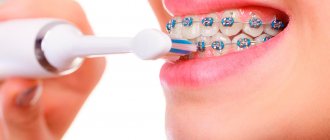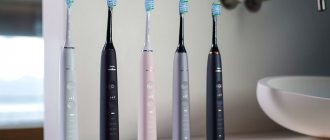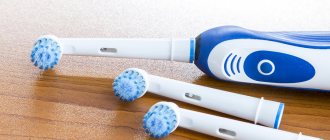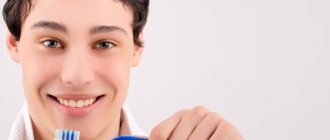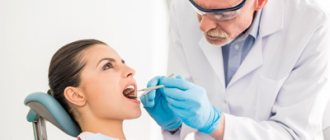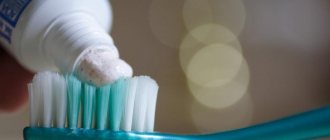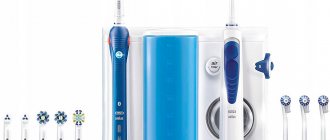The treatment process with an orthodontist requires responsibility from the patient, so you need to follow a number of rules - both in nutrition and in cleaning. The doctor will definitely tell you about this at the appointment. By themselves, neither aligners, nor even obsolete metal braces harm tooth enamel and do not cause caries. Only improper care, including insufficient hygiene, is harmful.
Those who wear aligners or braces need to get used to brushing their teeth constantly.
After eating, small particles of food always remain on the teeth. If it contained carbohydrates, an acidic environment immediately appears in the mouth, harmful to the enamel. But saliva, which has a slightly alkaline reaction, gradually washes away plaque and neutralizes the acid.
If the patient wears braces, this plaque becomes too much, since food gets clogged under the arch and remains around the braces. Saliva will not be able to “neutralize” all the acid. This does not happen with aligners because they are removed for eating. But if you put aligners on teeth that have not been cleaned, the plaque will remain under the aligner, and the acid will also destroy the enamel.
Therefore, all the basic rules during treatment with an orthodontist are related to teeth cleaning.
Brush your teeth after eating and drinking
This is the basis of the basics, the main rule of the orthodontist patient. You don't have to brush your teeth except after drinking water. If you have 3 main meals and 2 snacks during the day, then there should be 5 brushes and pastes. Only in this case will it be possible to wear braces or aligners for 12–15 months without harming your teeth.
Most of the food remains in the braces, and among all the systems, the most inconvenient in this sense are ligature ones. The arch is attached with rubber bands (ligatures), because of this, the braces themselves occupy a large surface of the tooth, food gets under the arch and under the ligatures.
Modern non-ligature braces are more convenient. They are small in size, their clasps into which the arc is attached are smooth, so large pieces of food usually do not get stuck in them. But you still need to brush your teeth constantly.
And removable aligners do not affect the nutrition process at all. The main thing is not to leave them wrapped in a napkin while eating (this can cause them to break). But with this system, you won’t be able to avoid brushing: after all, you need to put the aligners on your cleaned teeth immediately after eating.
What to do if you spend a lot of time away from home, at work or traveling? The solution is elixirs and other mouthwashes, disposable brushes with paste already applied to them. If you have absolutely nothing on hand, you can get by with rinsing with water. But this should not become a system.
Why is it so important to maintain oral hygiene?
Oral hygiene is of great importance in everyone's daily life. It must be observed both with and without braces. Otherwise, very unpleasant diseases may arise.
What can happen if you refuse hygiene:
- Raid. The teeth will begin to turn yellow, and plaque will accumulate on them. At first this will not be noticeable, but over time it will manifest itself and feel good. This spoils not only the teeth, but also the appearance of a person.
- Smell. If you neglect basic brushing of your teeth, germs and food debris will remind you of themselves with an unpleasant rotten smell, which will be a constant companion for those who do not do care procedures.
- Caries. Caries will become one of the most terrible diseases. It develops quite slowly, and eventually black rot and stones appear on the teeth, and the enamel begins to crumble and crack.
- Stomatitis. Less concerned with the teeth than with the oral cavity. The disease manifests itself on the tongue, cheeks, and gums in the form of small and large white spots, somewhat reminiscent of small ulcers. A burning sensation is usually felt.
- Health problems. Due to the huge accumulation of microbes, not only teeth, but also other organs can be damaged. Diseases such as diabetes, pneumonia, diseases of the respiratory and urinary systems appear.
If the condition of your body is important to you, then you should not give up oral hygiene. Otherwise, this leads to disastrous consequences, which cannot always be changed.
Take time to cleanse in the evening
At work or at university, it is difficult to clean your teeth efficiently, so once or twice a day you need to do a thorough cleaning using brushes. Each brush must be placed under the arch and the interdental spaces and the space under the arch must be cleaned. But this is only relevant for those who wear braces.
To clean braces, a brush with a brush is useful; when treating aligners, a regular or electric brush is sufficient.
It’s easier with aligners: you can brush your teeth with an ultrasonic electric toothbrush. They often have a timer that measures the required 2 minutes. To make sure that your teeth are clean, you can use an elixir with the function of “revealing” plaque - as a rule, after such a rinse, you have to brush your teeth again.
For convenience and comfort, all orthodontic patients can have an irrigator at home - a device that cleans teeth with a thin stream of water under pressure. Water literally “knocks out” all the remaining food from hard-to-reach places and massages the gums, which is useful not only during orthodontic treatment, but in general always.
An irrigator helps keep your teeth perfectly clean
Features of care when wearing braces
To clean braces, orthodontists had to develop a step-by-step care plan, including numerous accessories for comprehensive cleaning of the oral cavity: tooth enamel, interdental spaces, as well as the braces themselves outside and in accessible cavities.
Additionally, it was necessary to take into account the abundance of hard-to-reach areas and the intensity of plaque formation after eating. If you don’t understand how to brush your teeth with braces and follow your usual care regimen, the consequences can be serious:
- Destruction of the tooth crown and the onset of caries.
- Increased enamel sensitivity.
- Gum disease and frequent stomatitis.
- Termination of orthodontic treatment until the bite pathology is corrected.
- Bad breath.
The basis of the problems will be actively reproducing pathogenic microflora, which occurs due to pieces of food stuck in the structure and between the teeth. To remove the smallest microparticles of food and avoid the appearance of plaque, you must follow the rules for cleaning braces.
Have it professionally cleaned
Ultrasonic cleaning is not recommended if braces are installed - ultrasound can weaken the adhesive bond between the braces and the teeth. But Air Flow for fixed systems is completely safe. Such cleaning once every 4-5 months will help the entire treatment period pass without plaque, which provokes caries. Those who wear aligners can have both Air Flow and ultrasonic cleaning.
Plaque appears in all people, even in those who brush their teeth very carefully. Therefore, such cleaning is recommended to everyone approximately once every 6 months, and if indicated, a little more often.
When wearing braces and aligners, you should periodically undergo professional cleaning at the clinic.
Can I use an electric toothbrush?
Ultrasonic is not possible, conventional electric is possible. The first can lead to the plates coming off, the second should not have a moving head and strong vibration - this will not harm the braces, but it will be inconvenient for you to use such a brush, since the bristles will get stuck. You can use several toothbrushes at once - a regular one to clean the inner surface of the teeth, and an orthodontic one to clean the outer surface where the braces are located.
“The braces are fixed quite securely - you need to try hard to peel them off the surface of the teeth. Therefore, hygiene must be carried out without fear and in no case reducing its intensity, making allowances for braces. If the care is poor, after removing the system we will find caries and white spots on the enamel.”
Rustamova Gunel Bakhmanovna, dentist-orthodontist, work experience more than 4 years make an appointment
Avoid improvised means
If you don’t have a brush or toothpick at hand, you shouldn’t try to remove a stuck piece of meat with a straightened paper clip or needle. This is dangerous both for the braces system and for your own health. You can use special dental floss. When wearing a non-removable structure, its tip can be placed under the arch. Such cleaning requires care, otherwise you can tear the arc out of the grooves.
This is how you floss your teeth if you have braces.
What products will be needed for care?
To ensure thorough care of an orthodontic structure such as braces, a set of hygienic measures is needed. The following devices and tools will help provide them.
- Toothbrush.
It should have soft bristles that will not damage the structure. You can purchase a special orthodontic one. V-neck model with stubble.
- Paste with calcium and fluoride.
These substances in toothpaste will strengthen the enamel and help prevent the risk of damage.
- Ershik.
Special brushes help remove food debris and plaque from under the metal arch and around the brackets.
- Super floss.
Orthodontic dental floss designed specifically for cleaning braces, dentures and other dental structures.
- Irrigator.
This device is ideal for gentle and effective care of braces. To clean them of dirt, you need to buy a device with a special orthodontic attachment. The irrigator cleans the structure using a water jet under pressure and, additionally, the mechanical action of the bristles of the nozzle.
- Mouth rinse solution.
Its use soothes the gums and prevents the growth of bacteria.
Don't forget to drink water
Pure water quenches thirst well, refreshes the oral cavity and does not contribute to the appearance of plaque, unlike tea and coffee. If the mucous membrane of the lips is sufficiently moisturized, it is not susceptible to drying out (especially in winter, when indoor air is dry), which means there is less risk that the orthodontic system will cause irritation.
All these rules are simple, and you get used to them within the first few days after starting treatment. Once adapted, they are easy to follow and do not interfere with your active life. In addition, the habit of brushing your teeth thoroughly remains, as a rule, for life, which also contributes to maintaining health.
More articles:
- Back to the orthodontist? All about re-treatment
- What hurts more: braces or aligners?
Elastic bands for braces (traction)
Elastic bands for braces or traction are elastic rings that create additional load and reliably fix the arches to the braces, speeding up treatment.
There are several types of traction.
- Elastic
- rings that are put on braces installed on both the upper and lower teeth. The patient can change them himself. - Ligature rings
are small in diameter rings that are installed on each bracket to combine the plates with the arch into a single structure. - Chain rings
- they are connected alternately to form a chain. They are placed to eliminate wide interdental spaces.
Additional tools
The most important question is which toothpaste to brush teeth with braces? A doctor will answer this question and advise you on the option that will be optimal in your case. The choice will be made taking into account the characteristics of tooth enamel, as well as the type of nutrition. Mineral compounds will help strengthen teeth and protect them from the negative effects of external factors. Most likely, you will be prescribed an anti-caries toothpaste (here is a rating of the best).
Let's take a closer look at how to brush teeth with braces with a brush. Many people only learn about the presence of this device in the dental office. This simple device, which comes in various lengths and thicknesses, helps remove bacteria and food particles from the interdental space. By capturing the area under the gums, the brush significantly reduces the risk of developing root caries, and a gentle massage is an excellent prevention of periodontal disease. So let's get started:
- Take a brush and be sure to disinfect it before use. Half a glass of boiling water or a strong salt solution is suitable for this.
- Place it as close to the teeth as possible so that the small fibers extend under the gum.
- Using scrolling movements, brush your teeth from the root to the edge.
- Manipulation should be carried out first from the inside, then from the outside.
- When the main cleaning is done, you can use a brush to clean the areas near the metal locks installed on the teeth. They should be thoroughly cleaned on all sides. If necessary, you can add a little toothpaste, which will increase the abrasiveness.
Brushes come in varying degrees of hardness, which should also be taken into account. Buy only those recommended by your doctor. Carefully push the brush under the metal plate, and if it clearly does not fit there, do not try to apply force. This way, you can accidentally damage the structure, which will no longer perform its main function.
After treatment with a brush, you need dental floss. It will help remove all contaminants from the spaces between the teeth, which will reduce the risk of developing caries. In addition, super-floss copes well with plaque near metal structures. Remember how to clean braces with dental floss:
- Cut a small piece of thread and carefully pull it under the braces.
- Insert the floss between your teeth, imitating the letter “C”.
- Using gentle, smooth up and down movements, go over the entire area to the gums.
Note! You will need new floss to clean each tooth. It is convenient to cut it into strips and then use it, so as not to be distracted by this manipulation during the process.
Move softly and smoothly. If the gums are still damaged, the mouth should be rinsed with cool water.
How to properly clean braces if they are removable? In this case, the structure is removed and soaked in a special solution while the oral cavity is being hygienically cleaned. After this, the metal elements are cleaned with an abrasive brush and paste.
V-shaped brush for braces
Cleaning braces involves two multidirectional tasks: on the one hand, it is necessary to thoroughly clean out plaque and food particles, on the other hand, this must be done as carefully as possible so as not to damage the structure. Brushes with soft bristles and a special recess for locks - V-shaped - can handle this. They can clean the area around the bracket and the bracket itself at the same time. They tend to be more resilient when wet because they are made from polyester, which can absorb moisture better than the nylon used in regular brushes. And the soft bristles prevent damage to the gums and are suitable for increased tooth sensitivity.
What you can eat (and what you can't) if you wear braces
While you are getting used to having braces in your mouth, you should temporarily avoid eating solid food . Tooth pain is a result of orthodontic forces acting on the teeth. At this time, it is advisable to choose a gentle diet, which should also exclude very hot or cold foods. If a hard product cannot be replaced with soft food, it can be ground in a blender.
What not to eat while wearing braces
- lollipops;
- nuts;
- crackers;
- nougat and caramel;
- baked goods;
- foods containing high amounts of starch;
- foods and drinks containing dyes (black tea, carbonated drinks);
Hard foods can damage parts of the braces; sticky, viscous foods can cause plaque retention on teeth and braces. The use of dyes can lead to staining of sapphire brackets and areas of enamel at the border with the brackets.
What can you eat when you have braces?
- dairy products;
- cream soup;
- minced meat;
- soft fruits and vegetables.
These products do not stain tooth enamel, ceramic or sapphire braces, or stick to teeth, archwires, or clasps.
An important life hack for those who wear braces: try to drink more water, carry it with you when you are outside the house . Water will help prevent dry mouth and will help further rinse your braces after eating. Many patients wearing braces experience dry mouth, which creates favorable conditions for the development of caries. The better your teeth are moisturized, the lower the risk of developing caries.
